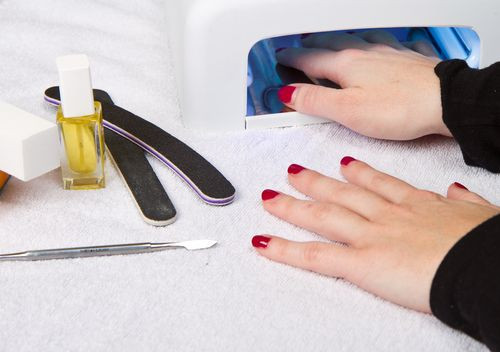UV Lamps At Nail Salons Linked To Skin Cancer: High Levels Of Radiation May Damage Your DNA

A typical visit to the nail salon includes cleaning, painting, and drying your nails under a lamp for five to 10 minutes. These lamps, used to dry and cure freshly painted nails, and to harden gel manicures, emit ultraviolet light (UVA) — the same kind used in tanning beds. According to a recent study published in the journal JAMA Dermatology, UV nail light devices at nail salons carry carcinogenic potential, which can possibly lead to DNA damage to the skin. Within just eight to 14 visits between 24 to 42 months, the lamps increase the risk of skin cancer.
“There is a vast range in the amount of light coming out of these devices,” said Dr. Lyndsay R. Shipp, lead author and a postgraduate resident at the university’s Medical College of Georgia, The New York Times reported. UV radiation in nail salons for drying and curing polishes have recently come under scrutiny due to concerns over the risk of skin cancer, although this risk is considered small, according to prior studies. Aware that nail polish drying lamps primarily emit UVA, Shipp and her colleagues were curious whether the use of a UVA and UVB light meter by Sper Scientific (model No. 850009) would pose a small or significant threat to clients.
The team of researchers from Georgia Regents University in Augusta did a random UV light sampling in nail salons in two geographic locations to accurately examine the differences in the amount of UV light radiated by various devices, and also measured exposure based on the positioning of hands. A total of 17 different UV lamps found in 16 nail salons were evaluated in the study to determine how much UV radiation was being emitted when the clients dried their nails under the lights in a single salon visit.
The findings revealed there was a wide variation in the dose of UVA emitted during eight minutes of nail drying or hardening. This dose is measured in joules per centimeter squared and ranged from less than one to eight in the study. There was a wide range of light source brands, bulb wattages, and number of bulbs per device. The UV lamps with higher-wattage sources emitted the highest levels of UV radiation. Differences in the amount of UVA exposure was also contingent on hand positioning on the device. Overall, the amount of UVA exposure ranged from “barely” to “significant.”
A single nail polish drying session under a UV lamp will not expose a person to cancer-causing amount of UVA light, as Shipp and her team wrote, "even with numerous exposures, the risk for carcinogenesis remains small." Typically, DNA damage that can lead to skin cancer is known to occur around 60 joules per centimeter squared, but none of the nail lamps evaluated in the study came close to this amount. However, the possibility of DNA damage to the skin, based on the lamps tested in the study, can happen in eight to 14 visits over 24 to 42 months.
"Our data suggest that, even with numerous exposures, the risk for carcinogensis, remains small. That said, we concur with previous authors in recommending use of physical blocking sunscreens or UV-A protective gloves to limit the risk of carcinogenesis and photoaging," said the researchers in the press release.
Shipp and her colleagues' investigation comes after a 2009 study published in the Archives of Dermatology, which found two healthy middle-aged women with no personal or family history of skin cancer developed nonmelanoma skin cancers on the dorsum of their hands. These women both reported previous exposure to UV nail lights, suggesting exposure to these UV lamps could be a risk factor for the development of skin cancer. Due to the lack of randomized light sampling from commercial salons, this study warranted further investigation. Shipp’s study does contest the possibility of a small risk for skin cancer, but it has yet to study the risk from multiple manicure visits.
More than 3.5 million skin cancers in over two million people are diagnosed annually, according to the Skin Cancer Foundation, making skin cancer the most common form of cancer in the U.S. Exposure to the human carcinogen, solar UV radiation, accounts for approximately 90 percent of nonmelanoma skin cancers. People between ages 19 and 59 will have accumulated an average of 47 to 74 percent of UV exposure in their lifetime.
Sources:
Davis LS, Rueggeberg FA, Shipp LR, Warner CA. Further Investigation Into the Risk of Skin Cancer Associated With the Use of UV Nail Lamps. JAMA Dermatology. 2014.
Alonso CA, MacFarlane DF. Occurrence of nonmelanoma skin cancers on the hands after UV nail light exposure. Archives of Dermatology. 2009.



























